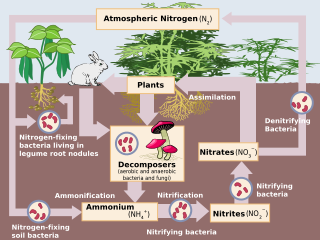Denitrification is a microbially facilitated process of nitrate reduction (performed by a large group of heterotrophic facultative anaerobic bacteria) that may ultimately produce molecular nitrogen (N2) through a series of intermediate gaseous nitrogen oxide products. This respiratory process reduces oxidized forms of nitrogen in response to the oxidation of an electron donor such as organic matter. The preferred nitrogen electron acceptors in order of most to least thermodynamically favorable include nitrate (NO3âˆ'), nitrite (NO2âˆ'), nitric oxide (NO), nitrous oxide (N2O) finally resulting in the production of dinitrogen (N2) completing the nitrogen cycle. Denitrifying microbes require a very low oxygen concentration of less than 10%, as well as organic C for energy. Since denitrification can lower leaching of NO3 to groundwater, it can be strategically used to treat sewage or animal residues of high nitrogen content. Denitrification allows for the production of N2O, which is a greenhouse gas that can have a considerable influence on global warming.
The process is performed primarily by heterotrophic bacteria (such as Paracoccus denitrificans and various pseudomonads), although autotrophic denitrifiers have also been identified (e.g., Thiobacillus denitrificans). Denitrifiers are represented in all main phylogenetic groups. Generally several species of bacteria are involved in the complete reduction of nitrate to molecular nitrogen, and more than one enzymatic pathway has been identified in the reduction process.
Direct reduction from nitrate to ammonium, a process known as dissimilatory nitrate reduction to ammonium or DNRA, is also possible for organisms that have the nrf-gene. This is less common than denitrification in most ecosystems as a means of nitrate reduction. Other genes known in microorganisms which denitrify include nir (nitrite reductase) and nos (nitrous oxide reductase) among others; organisms identified as having these genes include Alcaligenes faecalis, Alcaligenes xylosoxidans, many in the Pseudomonas genus, Bradyrhizobium japonicum, and Blastobacter denitrificans.
Nutrient limitation

All organisms require certain nutrients in their surroundings (available to them) for survival. Depending upon the ecosystem, nitrogen is most likely the limiting nutrient, although phosphorus is the other primary limiting nutrient and these two elements interact chemically. Some organisms appear to be able to denitrify and remove phosphorus. The triple bond of N2 makes this a very stable compound; most organisms (i.e. plants) depend upon others to break this down to make it available for biochemical reactions. See Nitrification. Symbiotic relationships between Rhizobium species and legumes are well-documented.
Conditions required
Denitrification takes place under special conditions in both terrestrial and marine ecosystems. In general, it occurs where oxygen, a more energetically favourable electron acceptor, is depleted, and bacteria respire nitrate as a substitute terminal electron acceptor. Due to the high concentration of oxygen in our atmosphere denitrification only takes place in anoxic environments where oxygen consumption exceeds the oxygen supply and where sufficient quantities of nitrate are present. These environments may include certain soils and groundwater, wetlands, oil reservoirs, poorly ventilated corners of the ocean, and in seafloor sediments.
Denitrification generally proceeds through some combination of the following intermediate forms:
- NO
3âˆ' â†' NO
2âˆ' â†' NO + N
2O â†' N
2 (g)
The complete denitrification process can be expressed as a redox reaction:
- 2 NO3âˆ' + 10 eâˆ' + 12 H+ â†' N2 + 6 H2O
This reaction shows a fractionation in isotope composition. Lighter isotopes of nitrogen are preferred in the reaction, leaving the heavier nitrogen isotopes in the residual matter. The process can cause delta-values of up to âˆ'40, where delta is a representation of the difference in isotopic composition. This can be used to identify denitrification processes in nature.
Deliberate use of process
Denitrification is commonly used to remove nitrogen from sewage and municipal wastewater. It is also an instrumental process in wetlands and riparian zones for the removal of excess nitrate from groundwater resulting from excessive agricultural or residential fertilizer usage. Wood chip bioreactors have been studied since the 2000's and are effective in removing nitrate from agricultural run off and even manure.
Reduction under anoxic conditions can also occur through process called anaerobic ammonium oxidation (anammox):
- NH4+ + NO2âˆ' â†' N2 + 2 H2O
In some wastewater treatment plants, small amounts of methanol, ethanol, acetate, glycerin, or proprietary products are added to the wastewater to provide a carbon source for the denitrification bacteria. Denitrification processes are also used in the treatment of industrial wastes.
Influence on global climate change
Increasing carbon dioxide levels within the atmosphere will influence global nutrient cycling, yet it is difficult to predict what those interactions might be. Chemical interactions between soils and the atmosphere will be influenced by changes in atmospheric composition. There are indications that increased fertilization of soils with nitrogen causes a decrease in carbon sequestration.
It has been shown that streams and rivers receiving nitrogen inputs from urban and agricultural land uses are a significant source of nitrous oxide to the atmosphere.
See also
- Aerobic denitrification
- Anaerobic respiration
- Bioremediation
- Climate change
- Hypoxia (environmental)
- Nitrogen fixation
- Simultaneous nitrification-denitrification
References
Literature
- Atlas, R.M., Barthas, R. Microbial Ecology: Fundamentals and Applications. 3rd Ed. Benjamin-Cummings Publishing. ISBN 0-8053-0653-6
- Zumft, W.G. (1997): Cell biology and molecular basis of denitrification. In: Microbiol. Mol. Biol. Rev. Bd. 61, Nr. 4, S. 533-616. PMID 9409151 PDF




0 komentar :
Posting Komentar